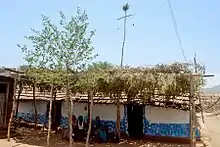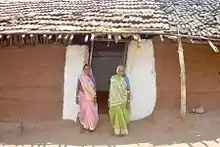Tadvi Bhil
The Tadvi Bhil is a tribal community found in the states of Maharashtra, Gujarat, Madhya Pradesh and Rajasthan in India. They are from the larger Bhil ethnic group, and are a clan of it. They use the surname Tadvi or sometimes the name of their Kul or Gan; the Dhankas of Gujarat and Maharashtra use Tadvi or Tetariya.[1]
| Tadvi Bhil | |
|---|---|
| Languages | Marathi and Bhili |
| Populated states | Maharashtra and Madhya Pradesh |
| Subdivisions | 12 main clans |


History and origin
The Tadvi Bhil inhabit an area which roughly covers the border areas of the states of Gujarat, Madhya Pradesh and Maharashtra. This territory forms the core of the Faruqi kingdom, a medieval state in central India. In the Western part of this area, Tadvis and Vasavas are mainly Hindu but some Christian missionary activities are seen in this region.[2] A close association between the Bhil of this region, and the Faruqi state led to the conversion of some of them to Islam. The dance that they perform on various occasions is known as Timli or Sajoni, or commonly known as tribal dance.
Present circumstance
The Tadvi speak a dialect of their own, also known as Tadvi, but many are switching to Marathi. Their language is also Dhanka and Bhilori, which belongs to the Bhil group. They inhabit villages which are largely Tadvi. The community consist mainly of small cultivators. Like the wider Bhil community, they currently practise gotra exogamy, and are endogamous.[3]
As of 2001, the Tadvi Bhil of Rajasthan were classified as a Scheduled Tribe under the Indian government's reservation program of positive discrimination.[4]
Tadvi Bhil and Tadvi tribe
The Tadvi Bhil tribe and the Tadvi tribe are two distinct tribes.[5] Tadvi Bhil are part of the Bhil ethnic group whereas the Tadvi tribe is not Bhil, but a sub-tribe of the Dhanka ethnic group. Dhanka, once itself under the Bhil, separated nearly 900 years ago.
Anthropologist Megan Moodie says about Dhanka history that what does exist "tend[s] to be brief and stress their 'insignificance' and lowness". She notes that they are a sub-tribe of the Bhil people, and that they are today found throughout much of western India.[6] Dhanka has 3 major sub-tribes; Tadvi, Tetaria and Valvi. Their occupations have changed over time, as circumstances have dictated. In the State of Maharahtra , the Tadvi tribe is mentioned at serial No.13 whereas the Tadvi Bhil is placed at serial no. 8 in List of Scheduled Tribes in Maharashtra[7] in accordance with The Scheduled Castes and Scheduled Tribes Orders (Amendment) Act 1976 (Act No.108 of 1976).[8] In the state of Gujrat , the Tadvi tribe is placed at serial No.8 and the Tadvi Bhil at serial No.4 in List of Scheduled Tribes in Gujrat [9] in accordance with Scheduled Castes and Scheduled Tribes Orders(Amendmen) Act,1976.[10] Tadvi tribe tribals also include population who adopted Islam similar to the Tadvi Bhil nearly 150-250 years ago. They speak Tadvi Boli Bhasha, unlike the Tadvi Bhil, who speak Bhilori. Both the tribes have a significant presence in the Dhule, Nandurbar and Jalgaon districts of Maharashtra State. Many Tadvi tribals migrated around the Marathwada region around 100-150 years ago, but Tadvi Bhil are found at the border of the Aurangabad and Jalgaon districts of Maharashtra state. The traditions of both tribes are similar but some differences exist.[11] A tribal of the Tadvi tribe was a famous chief leader among Pindari military , who continued to plunder the deccan areas during 1820's against East India Company .[12]
References
- "Tadvi | Scheduled Tribe | Tribes of Gujarat | Tribal Demography of Gujarat | Gujarat Tribal Research and Training Society".
- Brower, Barbara; Johnston, Barbara Rose (2007). Disappearing Peoples? Indigenous groups and ethnic minorities of south and central asia page 80-81. Left Coast Inc. and Routledge. ISBN 978-1-59874-121-6.
- Marginal Muslim Communities in India edited by M.K.A Siddiqui pages 1 to 13 Institute of Objective Studies
- "List of Scheduled Tribes". Census of India: Government of India. 7 March 2007. Retrieved 27 November 2012.
- "THE CONSTITUTION (SCHEDULED TRIBES) ORDER, 1950". Archived from the original on 20 September 2017. Retrieved 25 August 2017.
- Moodie, Megan (2015). We Were Adivasis: Aspiration in an Indian Scheduled Tribe. University of Chicago Press. pp. 29–30, 49f. ISBN 978-0-22625-304-6.
- https://trti.maharashtra.gov.in/index.php/en/list-of-scheduled-tribes
- https://socialjustice.gov.in/writereaddata/UploadFile/SC%20ST%20ORDER%20(AMENDMENT)%20ACT%201976.pdf
- https://tribal.nic.in/WriteReadData/CMS/Documents/201212010312287275390File1051.pdf
- https://socialjustice.gov.in/writereaddata/UploadFile/SC%20ST%20ORDER%20(AMENDMENT)%20ACT%201976.pdf
- Page no -136 . Book : आधुनिक महाराष्ट्राचा इतिहास (इ.स. १८१८ ते १९६०) / History of Modern Maharashtra (1818 to 1960) (link - https://books.google.com/books?id=dGX8DwAAQBAJ&pg=PT130
- Pindari Society and the Establishment of British Paramountcy in India
External links
 Media related to Tadvi Bhil at Wikimedia Commons
Media related to Tadvi Bhil at Wikimedia Commons